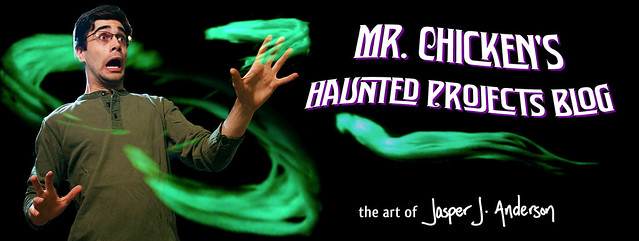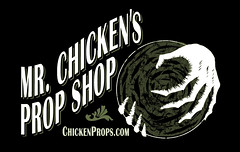Warning: it's lengthy, so you may prefer to listen. I did add in a couple of links here, though, in case you want to reference something I mentioned.
Good Evening. I’m Mr. Chicken, and
you’re entering my Hall of Illusions. Since this is your first
visit, I’m going to start by sharing some tips and tricks to
getting the most out of projection effects.
I’m going to talk about choosing a
projector, hiding the secret of your effect, video playback options,
alignment of projection effects, and a few other tricks I’ve picked
up in my experiements.
I’ve been making my own projection
effects since 2007, when I animated Davy Jones from Pirates of the
Caribbean appearing on the sail of my pirate ship. The next two
years I made and updated a recreation of Madame Leota from the
Haunted Mansion at Disneyland. You may have read my how-to. In
2012, I developed my Haunted Tombstone projection effects, and just
last month, I released Sybil the Clairvoyant, an update, and, dare I
say improvement upon my old Madame Leota.
Projection effects are a great thing
for home and professional haunters alike. Not all videos and setups
are cheap, but they’re high impact, have a low storage footprint,
and are very easy to set up.
So, let’s say you’ve made or
purchased a projection video. The first question most people have
next is “what projector should I use?” I don’t want to get too
specific on this, because like any electronic item, the products
available change frequently. But there are basically three types of
projectors from a haunter’s perspective. They are toy projectors,
pocket projectors, and real projectors. If my choice of words didn’t
clue you in yet, the real projectors are your best bet. These are
office and home theater models that are the brightest and have the
best picture quality. Pocket projectors, sometimes called pico
projectors, are aimed at office work and are usually meant to be
plugged into an iPod or something similar. I use the terms “pocket”
and “pico” interchangeably, but some companies differentiate
between the two. They’re much, much less bright than a good office
or home theater projector, but they tend to be decently designed and
will put out a nice picture as long as there isn’t too much light
around them. Last are the toy projectors. I have a fondness for
these because they’re really inexpensive (usually well under $100).
Though they’re as dim or dimmer than a pocket projector, and the
image quality isn’t nearly as consistent, they work well enough for
haunt use.
Now, if you use a pocket or toy
projector, you’ll get the best results if the projector is no more
than maybe 3 or four feet from the projection surface. This means
you’ll want to use those for smaller effects, since the screen size
won’t be as large. A real office or home theater projector gives
you many more options. If you’re serious about projection effects,
look on Ebay for used projectors. Try to find one that’s at least
1,000 lumens (that’s the measure of brightness) and make sure the
lamp has many hours left on it. Often those are more expensive to
replace than the projector itself. If you find one you’re
interested in, look it up on projectorcentral.com for all the specs
to make sure it will work with the other equipment you have and to
compare specs.
Now, does everyone have their
projector? Great. Now we can move on to the fun things.
When you use a digital projector,
there’s no such thing as blackness. There’s always light passing
through every part of the image, so what’s black on the video will
actually show up as grey on the projected image. So let’s say
you’re doing facial projection. Better yet, let’s say you’re
using my Sybil the Clairvoyant effect. There’s the face in the
middle of the video, and black space around it, but when you set it
up with your projector, that black space shows up as a grey box on
the wall behind her, and can give away the illusion. Fortunately,
there’s an easy fix. Basically, you’re going to create soft
shadows that blur those edges out into true blackness. Here’s the
simplest way to do it. Grab some strips of cardboard. They don’t
need to be more than a few inches wide and long. What you’re going
to do is use these strips to build a board with a rectangular opening
for the projection to pass through, but just barely clip off the
edges to fade them away. If your projector is on a table, this is
easy. Just start by taping the first strip down maybe 4-6 inches in
front of the projector so it just cuts off the bottom of the
projection. Play with the distance and height to get it to where you
feel the edge is not so noticeable, but not so much that it cuts into
the image you’re trying to project (the face, in my example). Then
tape two more strips to the bottom piece going vertically to make the
sides of the rectangle, again making slight adjustments until you
like how it looks. Do the same with a strip across the top, and you
should have nice feathered edges to your projection. If you want to
make it more circular, you can use this new rectangle as a template,
remembering its distance from the projector, or keep adding small
pieces to round out the corners. It’s much easier to create the
gobo, as it’s called in theatre, this way than by trial and error
of cutting holes in pieces of board.
Now, how do you get your video to play?
The nature of the effect will probably decide this for you. Some
effects, like my Haunted Tombstone, Sybil the Clairvoyant, the Ghost
Steps by VexFX, and Dminor’s ghost maid, exist in a world of their
own, more or less disregarding haunt patrons. Playing one of these
videos on a continuous loop is not only the easiest way to use them,
but it’s how they were designed. For effects that don’t come on
looping DVDs, you can either burn the video to a looping DVD yourself
(in iDVD, you just drag and drop the video file into the application,
select it, click Advanced and “loop video,” click burn, and
you’ll have your looping DVD ready in a half and hour) or you can
play the files off of a digital video playback device like an iPod, a
laptop, or a more professional video player, where you have the
option of playing in a loop.
Other projection effects you might want
to trigger from your other control systems. If you’re using VSA
for an animatronics routine, the new Pro and Ultimate versions of the
software allow you to synch a video with the routine, so your
projection effect could interact with your animatronics. Mike Fox’s
Night Frights offers a device that will allow a DVD to be triggered
when a sensor is tripped.
You can also trigger other props from
your projection video. Back in 2009, I edited the audio track of my
Madame Leota so the left audio channel had her voice going through a
speaker, and the right channel had nothing but audio tones that I
played through a Scary Terry board to trigger a fog machine in the
cauldron next to her, so the witch’s brew would flare up whenever
she said an incantation. Hi Rez designs offers a circuit board that
interprets the DTMF signals embedded in their videos to trigger
relays. The effect can be much like my cruder Scary Terry set up,
but because the signals are the same as what your telephone uses to
dial a number, multiple, different props can be triggered from the
DTMF track. It’s pretty spiffy, but a little more to wrap your
head around initially.
Alignment of projection effects is very
important. I’m going to start with a simple example. Pretend
you’ve got a Hallowindow you’re setting up in your front room.
You would want the image to cover the whole window, and not be skewed
off to one side, tilted, or at a distorted angle, right? The picture
would look weird. Once you get into more advanced projection
effects, this matters even more. When, for example, you set up the
projector for my Haunted Tombstone effect, it’s best to have the
image of the tombstone go slightly beyond the foam tombstone you cut
out, so there’s no end to the projected image on the projection
surface. You also want to have the projector pointed straight on.
Pretty basic, right? Now let’s say you’re setting up a facial
projection, like Sybil the Clairvoyant. You really have to be
careful that your projector is pointed straight at the head form,
that it’s at the right height, that it’s pointed at just the
right place on the head. Looking at the placement of the projected
nostrils on the nose is a good way to check this. If they get off,
things start looking really wonky. It’s like if you took your skin
and slid it around on your face. Weird stuff. But again, if you
make the projection go ever so slightly bigger than the form you’re
trying to project on, you tend to get the best results. There are no
formulas for this. It’s all just taking your time and making
things look as good to your eye as you can.
One last quick tip. I figured out that
you can use these little $4 cell phone wide angle "jelly lens"
from Ebay to make your pocket or toy projector have a wider angle.
It lets you put the projector closer to the projection surface, which
makes some difference when the projector is as dim as those ones.
For 4 bucks, it's worth playing with. I'd say it makes the image
about 50% larger.
That’ll do it for this time. This is
Mr. Chicken, and I’ll see you next time in my Hall of Illusions.


Thanks for the tips. Have wanted to get into this a bit but coming up with a good projector at a decent price has been difficult. Will have to give it a bit more effort this year. Thanks again!
ReplyDeleteWhat size crystal ball..?
ReplyDeleteHi there, I use a 16" globe currently, but I've also had luck with 14". You can order the Sybil kit with my crystal ball base and the globe at ChickenProps.com, if it suits you.
Delete